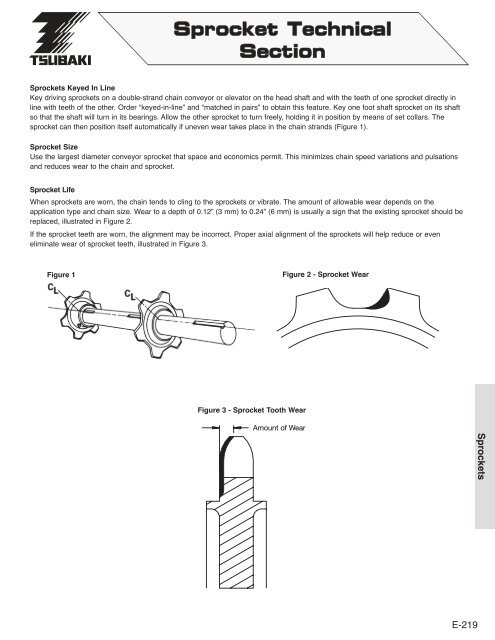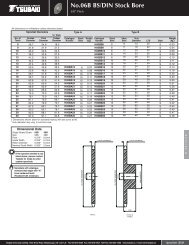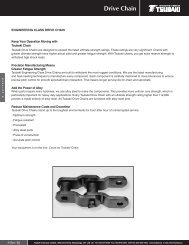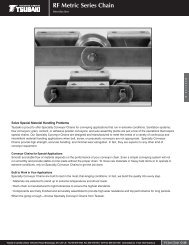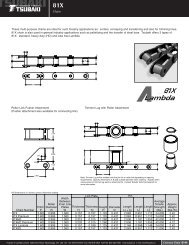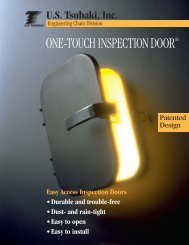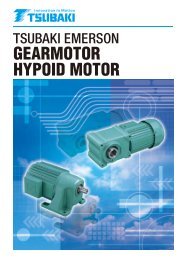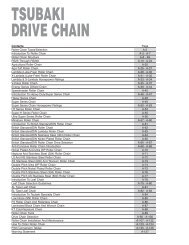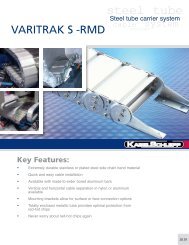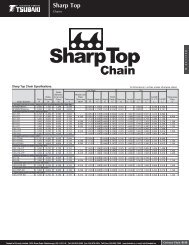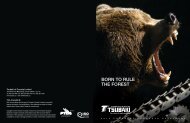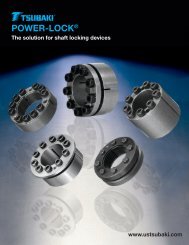- Page 2 and 3:
Made-to-Order SprocketsOur Capabili
- Page 4 and 5:
Made-to-Order SprocketsEngineering
- Page 6 and 7:
Made-to-Order SprocketsBore Options
- Page 8 and 9:
Made-to-Order SprocketsSplit Sprock
- Page 10 and 11:
Made-to-Order SprocketsSegmental Ri
- Page 12 and 13:
Roller ChainSprocket Part NumbersHo
- Page 14 and 15:
No.25Stock Bore1/4” PitchAll dime
- Page 16 and 17:
No.35Stock Bore3/8” PitchSprocket
- Page 18 and 19:
No.35Stainless Steel3/8” PitchAll
- Page 20 and 21:
No.35Single/Double“Taper-Lock”
- Page 22 and 23:
No.35Split Taper3/8” PitchAll dim
- Page 24 and 25:
No.41Finished Bore1/2” PitchAll d
- Page 26 and 27:
No.41“QD” Style1/2” PitchAll
- Page 28 and 29:
No.40Stock Bore1/2” PitchAll dime
- Page 30 and 31:
No.40Finished Bore1/2” PitchSproc
- Page 32 and 33:
No.40Multiple Strand1/2” PitchAll
- Page 34 and 35:
No.40Single“Taper-Lock” Style1/
- Page 36 and 37:
No.40“QD” Style1/2” PitchAll
- Page 38 and 39:
No.40SingleSplit Taper1/2” PitchA
- Page 40 and 41:
No.40TripleSplit Taper1/2” PitchA
- Page 42 and 43:
No.50Stock Bore5/8” PitchAll dime
- Page 44 and 45:
No.50Stainless Steel5/8” PitchAll
- Page 46 and 47:
No.50Double Single5/8” PitchSTOCK
- Page 48 and 49:
No.50Double“Taper-Lock” Style5/
- Page 50 and 51:
No.50SingleSplit Taper5/8” PitchA
- Page 52 and 53:
No.50SingleSplit Taper5/8” PitchA
- Page 54 and 55:
No.50TripleSplit Taper5/8” PitchA
- Page 56 and 57:
No.60Stock Bore3/4” PitchSprocket
- Page 58 and 59:
No.60Stainless Steel3/4” PitchAll
- Page 60 and 61:
No.60Double Single3/4” PitchSTOCK
- Page 62 and 63:
No.60Double“Taper-Lock” Style3/
- Page 64 and 65:
No.60SingleSplit Taper3/4” PitchS
- Page 66 and 67:
No.60DoubleSplit Taper3/4” PitchA
- Page 68 and 69:
No.80Stock Bore1” PitchAll dimens
- Page 70 and 71:
E-70SprocketsFinished Bore1” Pitc
- Page 72 and 73:
No.80Multiple Strand1” PitchAll d
- Page 74 and 75:
No.80Single“Taper-Lock” Style1
- Page 76 and 77:
FFFNo.80“QD” Style1” PitchSpr
- Page 78 and 79:
No.80SingleSplit Taper1” PitchAll
- Page 80 and 81:
No.80TripleSplit Taper1” PitchAll
- Page 82 and 83:
No.100Finished Bore1 1/4” PitchAl
- Page 84 and 85:
No.100Double Single1 1/4” PitchST
- Page 86 and 87:
No.100“QD” Style1 1/4” PitchA
- Page 88 and 89:
No.100DoubleSplit Taper1 1/4” Pit
- Page 90 and 91:
No.120Multiple Strand1 1/2” Pitch
- Page 92 and 93:
No.120“QD” Style1 1/2” PitchA
- Page 94 and 95:
No.120DoubleSplit Taper1 1/2” Pit
- Page 96 and 97:
No.140Multiple Strand1 3/4” Pitch
- Page 98 and 99:
FFFFNo.140“QD” Style1 3/4” Pi
- Page 100 and 101:
No.160Stock Bore2” PitchAll dimen
- Page 102 and 103:
No.160Single“Taper-Lock” Style2
- Page 104 and 105:
No.160Split Taper2” PitchAll dime
- Page 106 and 107:
No.200Stock Bore2 1/2” PitchAll d
- Page 108 and 109:
No.200Split Taper2 1/2” PitchAll
- Page 110 and 111:
No.2040Double Pitch1” Pitch Doubl
- Page 112:
No.2050Double Pitch1 1/4” Pitch D
- Page 115 and 116:
Double Pitch1 1/2” PitchNo.2062 D
- Page 117 and 118:
Double Pitch2” Pitch No.2082 Doub
- Page 119 and 120:
Idler Sprockets &Chain TensionersAd
- Page 121 and 122:
BS/DINStock Bore3/8” PitchNo.06BA
- Page 123 and 124:
BS/DINStock Bore1/2” PitchNo.08BA
- Page 125 and 126:
BS/DINStock Bore5/8” PitchNo.10BA
- Page 127 and 128:
BS/DINStock Bore3/4” PitchNo.12BA
- Page 129 and 130:
BS/DINStock Bore1” PitchNo.16BAll
- Page 131 and 132:
BS/DINStock Bore1 1/4” PitchNo.20
- Page 133 and 134:
BS/DINStock Bore1 1/2” PitchNo.24
- Page 135 and 136:
BS/DINStock Bore2” PitchNo.32BAll
- Page 137 and 138:
“Taper-Lock” Style Bushings3535
- Page 139 and 140:
Split Taper BushingsType 1G & H Bus
- Page 141 and 142:
“XT” Style Bushings“XT” sty
- Page 143 and 144:
“QD” Style Weld-On HubsTsubaki
- Page 145 and 146:
“XT” Style Weld-On Hubs“XT”
- Page 147 and 148:
Flexible Chain Couplings Coupling C
- Page 149 and 150:
Engineering ClassSprocketsChains an
- Page 151 and 152:
Drive ChainSprocketsSprocket Number
- Page 153 and 154:
Drive ChainSprocketsSprocket Number
- Page 155 and 156:
Drive ChainSprocketsSprocket Number
- Page 157 and 158:
Drive ChainSprocketsSprocket Number
- Page 159 and 160:
Roller ConveyorChain SprocketsSproc
- Page 161 and 162:
Roller ConveyorChain SprocketsSproc
- Page 163 and 164:
Roller ConveyorChain SprocketsSproc
- Page 165 and 166:
Roller ConveyorChain SprocketsSproc
- Page 167 and 168: Roller ConveyorChain SprocketsSproc
- Page 169 and 170: Roller ConveyorChain SprocketsSproc
- Page 171 and 172: Roller ConveyorChain SprocketsSproc
- Page 173 and 174: Roller ConveyorChain SprocketsSproc
- Page 175 and 176: Roller ConveyorChain SprocketsSproc
- Page 177 and 178: Roller ConveyorChain SprocketsSproc
- Page 179 and 180: Steel BushedChain SprocketsSprocket
- Page 181 and 182: Steel BushedChain SprocketsSprocket
- Page 183 and 184: Steel BushedChain SprocketsSprocket
- Page 185 and 186: Welded SteelChain SprocketsSprocket
- Page 187 and 188: Welded SteelChain SprocketsSprocket
- Page 189 and 190: Welded SteelChain SprocketsSprocket
- Page 191 and 192: Welded SteelChain SprocketsSprocket
- Page 193 and 194: Asphalt InclineChain SprocketsSproc
- Page 195 and 196: Drop Forged RivetlessChain Sprocket
- Page 197 and 198: ACR Type CollectorTank SprocketsACR
- Page 199 and 200: JAC Type Bar ScreenSprocketsJAC1015
- Page 201 and 202: ACS Type Heavy DutyCollector Tank S
- Page 203 and 204: ACS Type Heavy DutyCollector Tank S
- Page 205 and 206: Sprocket TechnicalSectionSpecific i
- Page 207 and 208: Sprocket TechnicalSectionHub Type i
- Page 209 and 210: Sprocket TechnicalSection180Suggest
- Page 211 and 212: Sprocket TechnicalSectionSprocket S
- Page 213 and 214: Sprocket TechnicalSectionOther Fact
- Page 215 and 216: Sprocket TechnicalSectionTable 7 -
- Page 217: Sprocket TechnicalSectionSprocket H
- Page 221 and 222: Universal ProductCross-ReferenceThi
- Page 223 and 224: Universal ProductCross-ReferenceCha
- Page 225 and 226: Universal ProductCross-ReferenceCha
- Page 227 and 228: Universal ProductCross-ReferenceCha
- Page 229 and 230: Universal ProductCross-ReferenceCha
- Page 231 and 232: Universal ProductCross-ReferenceCha
- Page 233 and 234: Universal ProductCross-ReferenceCha
- Page 235 and 236: Universal ProductCross-ReferenceCha
- Page 237: Universal ProductCross-ReferenceCha


